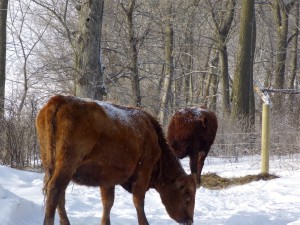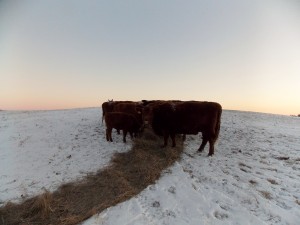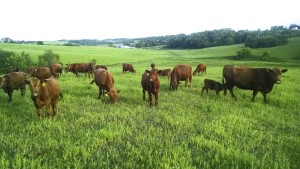
Today it seems like everyone is prepared for whatever Mother Nature throws at them. Cell phones, GPS, four wheel drive, and accurate weather forecasts give a feeling of safety. A false sense of security blankets our instinct to avoid dangerous situations.
Because we farm - we're weather dependent. We plan for worse case scenarios like feeding hay when equipment won't start, frozen waterlines, power outages, etc. There's a basic plan for just about every weather event.
When the windchill falls below zero the cattle are fed along the timber. The trees make a great windbreak. Bales of hay and straw are unrolled for feed and bedding.
Planning ahead is essential, the livestock depend on us.
Sometimes, when it comes to running errands or grocery shopping, we aren't as diligent and get caught off-guard.
Without moonlight to guide us, our path was illuminated by farmyard lights. We walked through the hills. We parked the truck on the side of the road. It was a surprisingly pleasant evening for a walk, temperatures near 30 degrees, very little wind, the drizzle was nearly over. We watched our footing carefully, a layer of ice covered the ground. As we walked I remembered reading about The Children's Blizzard of 1888.
The Blizzard of 1888
After weeks of bitter cold temperatures a moderate warming was a welcome relief on the prairies. Temperatures approached near 45 degrees on January 12, 1888. Farmers ventured out to replenish supplies of hay and visit town to conduct business. Children, lightly dressed, walked to school. They were eager to see friends, play outdoors, and enjoy the comparatively balmy weather.
In 1888 twenty-two weather stations, overseen by the Signal Corp, monitored weather data and relayed the information by Western Union to sixty “Flag Stations” throughout the prairie states to keep pioneers informed. On this day the message to fly the “cold wave” and “blizzard” flags never reached the volunteer flagmen. Warnings never came or arrived too late for the settlers of the Dakotas and Nebraska. They were caught off guard.
In the Dakota Territory the lunch hour had just ended. Children were at their desks when the wind began to howl in an eerie wail. A dark cloud descended rapidly from the northwest. Within minutes the sun disappeared, by all accounts nightfall had arrived. Ice crystals blasted the clapboard buildings. The wailing wind was deafening. Snow swirled in through every crevice. Gale force winds gusted to nearly eighty miles per hour.
Pioneers that lived through the blizzard of 1873, and the 1880 “snow winter,” where thousands of cattle froze to death on the prairie, had never seen a storm arrive with such speed and violence.
Visibility on this January day was so poor you couldn’t see more than a few inches ahead. Folks on the prairie were snow blinded by the blizzard, many died within a few steps of their homes.
The Children
Many teachers released school and sent their students into the storm. The children became disoriented and couldn’t find their way home. In other schoolhouses teachers kept their students inside. When the supply of coal, school books, and desk were exhausted they surrounding cold stoves praying for rescue. They clung together for warmth.
Parents anxiously awaited the arrival of their children. Rescue parties searched schools and bare prairies. Hope of finding loved ones faded as the temperature fell and the storm raged on. Mothers stood in doorways calling out for their children. With their voices exhausted they rang cow bells or beat pots. They hoped the sound would direct their children home. The wind chill fell to 30 degrees below zero.

Farmers
Farmers watering their cattle or out gathering hay from their stacks got caught by the storm. They knew from experience to get under the storm; visibility is better close to the ground. They crawled to find shelter.
In Minnesota a large number of farmers died when they became disoriented after securing their livestock. They couldn't find their houses which were just steps from their lean-to or dugout barns.
Iowa fared better, the storm didn’t rage here until dusk. Chores and errands were done for the day. In Keokuk, Iowa the temperature plummeted 50 degrees in eight hours. Company B, Second Regiment from Davenport, Iowa was headed to Des Moines to escort William Larabee in his inauguration parade. Company B, trapped by the storm, did not arrive.
The Weather System
The weather term for such a storm is anticyclone. Winds spiral inward toward the center of low pressure in a counter-clockwise pattern. The lowest air pressure was over Iowa and Nebraska. Higher pressure over North Dakota and Montana caused a vacuum effect over the mid-section of the country. Cold rushing air created great friction and static build-up. Snow thunderstorms raged across the plains. A phenomenon known as St. Elmo’s fire caused static build-up. The air was electrified. Sparks emitted from people's fingertips and caused hair to stand on end. The shocks were so fierce the pioneers refused to add fuel to fires.
The Aftermath
Children buried themselves in haystacks, huddled together in darkened classrooms, or froze to death on the prairie while searching for shelter. This was the fate of those caught in the blizzard.
On Friday, January 13, 1888 skies were clear, the air was bitter cold. Relieved students and teachers were grateful to be found alive. One teacher, who had ventured outdoors with her seven students found safety inside a haystack. They were alive, barely. Another teacher acted swiftly when the storm tore the school's roof away. Tying a makeshift rope out of torn cloth she tied her students together. Walking in a line, eyes frozen shut, they hit the side of a building and were saved.
Other unfortunate children got caught in the storm and were found frozen to death.
It's estimated that two hundred fifty fatalities littered the prairies, most of them children. Countless survivors of the initial storm succumbed to infection when frostbitten limbs were amputated. Others perished from pneumonia. It's estimated that this storm claimed five hundred lives.
That was then, This is now
When our truck wasn't able to compete with the ice we packed our gear and started walking. We talked about survival skills and common sense ideas…like staying home.


